- Submissions

Full Text
Advancements in Civil Engineering & Technology
A New Green and Biocidal Concept for Coatings in Architectural Applications
Hamidreza Salimijazi1*, Larry Pershin2, Javad Mostaghimi2 and Majid Shobeiri3
1Department of Materials Engineering, Isfahan University of Technology, Isfahan, Iran
22Department of Mechanical and Industrial Engineering, University of Toronto, Canada
3Exycoat Inc, Toronto, Canada
*Corresponding author: Hamidreza Salimijazi, Department of Materials Engineering, Isfahan University of Technology, Isfahan, Iran
Submission: December 08, 2021;Published: February 03, 2022

ISSN: 2639-0574 Volume 5 Issue 1
Abstract
In the current research, metal coatings applied by Twin-Wire Arc spraying technique was used for decorative and protective coatings application for architectural elements and furniture. Aluminum, copper and its alloys (brass, bronze) were deposited on ceramic tiles, hardwoods and medium density fiberboards, for both interior and exterior applications. The coated parts were installed either as sprayed or after the coating surface finishing. In exterior applications for added protection, the coatings porosity was sealed by a penetrating sealant. The coatings microstructure was examined under optical and scanning electron microscopes and their adhesion to substrates was measured according to the standard pull-off test. The coating visual appearance did not show any significant changes after exposure to the urban environment for more than five years. The coated furniture was cleaned regularly by the conventional detergents and after two years no changes in color or tarnishing of the coatings were observed. Copper alloy coatings have provided important additional benefit to be a potent biocidal surface. Since, the outbreak of COVID-19 virus has become a global pandemic, the copper alloy coated touch surfaces can be a way to prevent the human-to-human transmissions of virus and pathogens via infected surfaces.
Keywords:Twin-Wire Arc spray; Biocidal surface; Architecture; Green technology; Metallic coating
Introduction
There are numerous methods for applying protective coatings on industrial components, such as hot-dip, physical vapor deposition, chemical vapor deposition and various thermal spray methods [1-6]. The thermal spray is a very flexible technology commonly used in aerospace, automotive and chemical industries for deposition of various coatings to protect parts from wear and corrosion. These coatings have high adhesion and applied without use of hazardous chemicals, unlike painting which releases volatile organic compounds (VOCs) or electroplating with the cancerogenic electrolytes. It could help to reduce the sick building syndrome [7]. Additionally, there is no size limitation for parts that can be coated with thermal spray unlike most other metalizing techniques. Amongst various methods of thermal spraying, the Twin-Wire Arc (TWA) spray is the most cost effective, portable and easy to operate for deposition on various types of substrates [8]. It can also be used for on-site deposition to coat large and complex structures such as vessels, bridges, and offshore platforms. The TWA technique utilizes two wires as consumable electrodes, an electric arc initiated between tips of the wires melts them and the molten metal atomized by a high-pressure gas and projected towards the substrate as a plume of fine droplets. Upon the impact the molten droplets instantly solidified and form so-called “splats”-building blocks of the coating. The multiple splats formed the coating while moving a torch over a substrate a sufficient coating thickness can be deposited [9-11]. Due to their small sizes, the particles have very low heat capacity. As a result, the particles quickly solidify on a substrate without damaging heat sensitive surfaces. Adhesion between the coating and substrate based mostly on mechanical interlocking, for this, the surface must be clean and roughened before the deposition. There is no need for any polymer or chemical binder to promote the adhesion. The coating process is environmentally benign, the metal coatings contain zero VOCs, do not require any drying time and the coating post-processing, if needed, may start immediately.
Metals such as silver, copper and zinc have been demonstrated to effectively kill on contact a range of bacteria. This may provide additional benefits for items or furniture in public places or health care facilities. Copper alloys are the most promising because of their availability, better corrosion resistance than zinc, and cost in comparison to silver. Alloys of these metals form redoxactive surfaces that are deadly to bacteria and viruses. However, production of equipment/furniture using sheet metals has limited applications due to their high cost and manufacturing limitations. We previously reported that the copper alloy coatings lead to the rapid contact killing of E. coli and endospore-forming bacteria S. epidermidis within minutes [12,13]. The thermal spraying of surfaces with biocidal copper alloys could provide a cost-effective solution to a major health concern. Due to the specifics of the thermal spray process such as the small droplet size and rapid solidification, the coatings microstructures consist of ultrafine grains, oxide layers, and micropores. Our studies have shown that wire-arc coatings have higher biocidal activity in comparison to sheet metal with similar composition [14-16].
Wire arc sprayed coatings, in addition to making the wood more aesthetically appealing, also able to protect the substrate from, ultraviolet radiation, mildew and increase its fire retardation [17,18]. During the COVID 19 pandemic human-to-human transmissions have been one of the major challenges in controlling of the outbreak. The virus can spread by infected droplets and through the contaminated surfaces. It was reported that the coronavirus can persist long period on inanimate surfaces such as metals, glasses, fabrics, and plastics. For instance, the coronavirus can remain infectious for around 48 hours on steel and fabric surfaces, more than 4 days on wood and plastic surfaces and only 3 hours on copper surfaces [19-20]. A wide variety of the coatings finishes can be obtained by selecting of the copper alloy composition (brass,bronze, etc.) and post-processing techniques (polishing and/or patining). In the current study twin-wire arc spraying was used for coating of nonmetallic structures for decorative and architectural applications.
Materials and Methods
As the feedstock materials, we used wires of aluminum, phosphor bronze (Cu-Sn-P) and Cu-Ni-Zn alloy often referred as German silver because its silver color. TWA system from GTV (Luckenbach, Germany) was used for coatings deposition and compressed air as atomizing gas. The spray torch was mounted on a robot which scanned the to-be-coated surface at a spray distance 200mm. The coatings were deposited on wide variety of substrates such as ceramic tiles, hardwood and medium density fiber (MDF) boards. For the first time, TWA was used for coating of exterior of a large residential house. The entire house exterior surfaces were covered by 600 by 600mm2 porcelain tiles that were sprayed by various metals to produce different colors for designated areas. To increase the coating adhesion the tile surface was roughened by grit blasting prior to coating. After that, the coatings of aluminum and German silver with thickness 100-150μm were deposited on the tiles. Because the coated ceramic tiles will be exposed to a large city atmosphere with seasonal changes (moisture, rain, snow) and significant urban pollution, an organic low viscosity sealant was used to fill and close the coatings porosity [14].
The coating adhesion strength was measured according to ASTM D4541standard, using 20mm dollies [21]. The dollies were glued to the coated surfaces using an epoxy adhesive and the adhesion estimated by a force to pull them off from the coating by adhesion tester Posi Test AT-M (DeFelsko Corp. USA). At least three measurements were performed on each sample.
Results and Discussion
Figure 1 :The house exterior with the ceramic tiles coated by Aluminum (light color) and German silver (dark color) right after installation (Left) and after 5 years (Right).
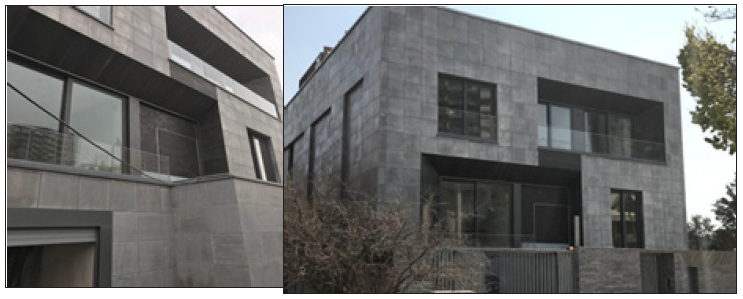
Figure 1 shows aluminum and German silver coated tiles on the house walls right after installation (left image) and for a comparison, the same house after more than five years of exposure to the urban environment. Figure 2 provides a close-up view of the aluminum coated tiles after 5 years in service. Substrates for interior and furniture applications were various hardwoods and MDF, which were subsequently coated by aluminum, copper, brass, bronze, and German silver as per interior designers’ request. Then, the coated pieces were used in furniture production and other interiors applications, several examples are shown in Figure 3. The as-sprayed surface roughness can be improved by polishing to a desired smoothness and can even reach the mirror-like surface finish. Examples of kitchen cabinets with the metal coatings shown in Figure 4, as it can be seen, the polished metal coatings can reproduce in high details the underlying wood grains and topography.
Figure 2 :The house exterior after 5 years (close up view of the aluminum coating).
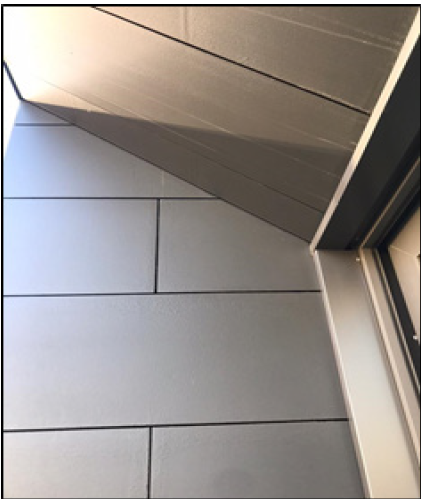
Figure 3 :Examples of metal coated interior installations. Curved mahogany before and after copper coating (a), MDF installation with different metal coatings (b) and painted copper coating on wood beams (c)..

Figure 4 :Brass (golden color), patina copper, and German silver coating on kitchen cabinets.
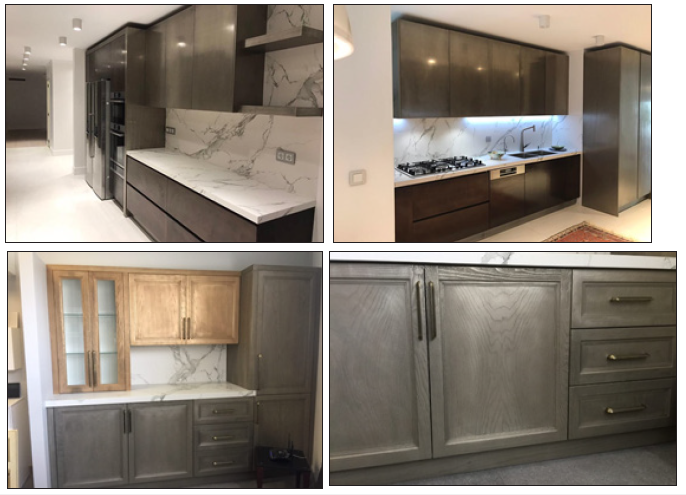
Coating’s characterizat
For the coating microstructure observations, they were cut by a diamond saw, mounted in an epoxy resin and polished. The polished cross-sections were analyzed under a scanning electron (SEM) and an optical microscope. Figure 5 shows the cross-section and top view of the aluminum coating on a ceramic tile. The coating thickness was around 100μm, with a good, defect free interface between the coating and the substrate. The as deposited coating shows surface with an average roughness Ra~10μm which is due to grit blasting of the tile surface and the specifics of the coatings formation from solidified splats.
Figure 5 :Scanning electron microscope images of the aluminum coating cross-section on ceramic tiles.
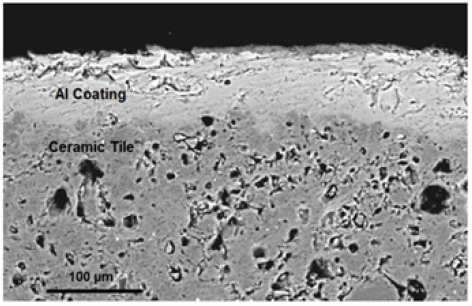
Copper coatings microstructure on MDF and hardwood (mahogany) also demonstrates good coating-substrate interface (Figure 6) with deep penetration and interlocking of the metal into the substrate grains. The coating thickness was around 250μm. Since the bonding adhesion of the thermal sprayed coating is provided by mechanical interlocking of quickly solidified metal droplets into substrate asperities, the adhesion of metal to wood is greatly influenced by the wood surface morphology, which varies with wood species but can be enhanced by the surface preparation.
Figure 6 :Microstructure of the coatings on MDF and hardwood (mahogany) substrates.

The results for the adhesion tests of the copper alloy coatings to various wood species presented in Figure 7. Overall, the adhesion of the copper coating to both hardwoods and softwoods species was very good; the values were lower than the wood tensile strength for oak but higher than the wood strength for other samples. The adhesion to the MDF substrates was the lowest in comparison to solid woods. In this case, the coating adhesion was higher than the cohesion of bulk MDF (Figure 8). In some cases, the wood fibers were pulled with the coating, the indication that the coating adhesion was comparable with the wood cohesion. The bonding adhesion of copper coating on steel substrates was measured to be around 20MPa, which is high enough to be well-adhered to the substrates.
Figure 7 :Adhesion strength of copper coatings to different wood species.
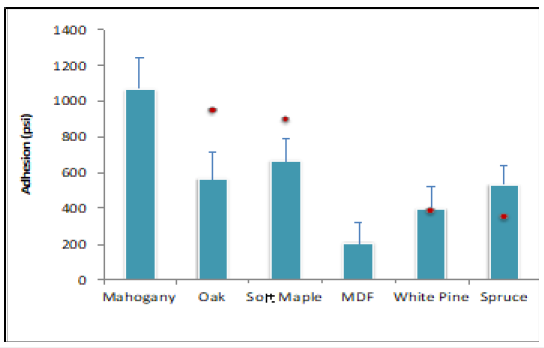
Figure 8 :Images of the copper coating adhesion results to MDF (top), mahogany wood and terracotta tiles (bottom).

Conclusion
The study indicates that thermal spray technology offers promising and cost-effective way of coating complex threedimensional surfaces with metals for functional and decorative purposes. The coatings can exhibit unique surface finish from mirror like to rough surfaces. The wire arc deposited coatings provide an esthetical and long-lasting finish for external surfaces in a large city environment. It was confirmed that the thermal spray metal coatings have sufficient adhesion to tiles, hardwoods and wood composites. The coatings from copper and its alloys provide the additional benefit as an antimicrobial surface. They can prevent the spreading of Covid-19 virus on the frequently touch surfaces in health care and public facilities. Copper coating on wood would be a great value-added opportunity for a wide variety of items.
Authors’ Contribution
All authors contributed equally to the preparation of this article.
References
- Marder AR (2000) The metallurgy of zinc-coated steel. Prog Mater Sci 45(3): 191-271.
- Vagge AR, Raja VS, Ganesh Narayanan R (2007) Effect of deformation on the electrochemical behavior of hot-dip galvanized steel sheets. Appl Surf Sci 253: 8415-8421.
- Smith WJ, Goodwin FE (2010) Hot dipped coatings. Shreir’s Corros 4: 2556-2576.
- Guzman L, Adami M, Gissler W, Klose S, De Rossi S (2000) Vapor deposited Zn-Cr Alloy coatings for enhanced manufacturing and corrosion resistance of steel sheets. Surf Coat Technol 125(1-3): 218-222.
- Baker MA, Gissler W, Klose S, Trampert M, Weber F (2000) Morphologies and corrosion properties of PVD Zn–Al coatings. Surf Coat Technol 125(1-3): 207-211.
- Sugama T (1999) CVD-titanium carbonitride coatings as corrosion-preventing barriers for steel in acid-brine steam at 200 °C. Mater Lett 38: 227-234.
- Hosseini M, Foulad-Fard R, Aali R (2020) COVID-19 pandemic and sick building syndrome. Indoor Built Environ 29: 1181-1183.
- Jandin G, Liao H, Feng ZQ, Coddet C (2003) Correlations between operating conditions, microstructure and mechanical properties of twin wire arc sprayed steel coatings. Mater Sci Eng A 349(1-2): 298-305.
- Pawlowski L (2008) The Science and Engineering of Thermal Spray Coatings. (2nd edn), John Wiley & Sons Ltd, West Sussex.
- Han MS, Woo YB, Ko SC, Jeong YJ, Jang SK, et al. (2009) Effects of thickness of Al thermal spray coating for STS 304. Trans Nonferrous Met Soc China 19: 925-929.
- Abedi Esfahani E, Salimijazi HR, Golozar M, Mostaghimi J, Pershin L (2012) Study of corrosion behavior of wire arc sprayed aluminum coating on mild steel. Journal of Thermal Spray Technology 21(6): 1195-1202.
- Gutierrez H, Portman T, Pershin V, Ringuette M (2013) Evaluation of biocidal efficacy of copper alloy coatings in comparison with solid metal surfaces: generation of organic copper phosphate nanoflowers. J Appl Microbiol 114(3): 680-687.
- Grass G, Rensing C, Solioz M (2011) Metallic copper as an antimicrobial surface. Appl Environ Microbiol 77(5): 1541-1547.
- Sharifahmadian O, Salimijazi HR, Fathi MH, Mostaghimi J, Pershin L (2013) Relationship between surface properties and antibacterial behavior of wire arc spray copper coatings. Surface and Coatings Technology 233: 74-79.
- Sharifahmadian O, Salimijazi HR, Fathi MH, Mostaghimi J, Pershin L (2013) Study of the antibacterial behavior of wire arc sprayed copper coatings. Journal of Thermal Spray Technology. 22: 371-379.
- Shafaghi R, Mostaghimi J, Pershin V, Ringuette M (2017) Sporicidal efficacy of thermal- sprayed copper alloy coating. Can J Microbiol 63: 384-391.
- Liu LM, Wang Zh, Song G (2010) Study on corrosion resistance properties of hydrothermal sealed arc sprayed aluminum coating. Surf Eng 26: 399-406.
- Nejad M, Shafaghi R, Pershin L, Mostaghimi J, Cooper P (2013) Copper coating on wood: A new way of protecting wood. Proceedings of the IRG 44th Annual Meeting Stockholm. Sweden.
- Kampf G, Todt D, Pfaender S, Steinmann E (2020) Persistence of coronaviruses on inanimate surfaces and their inactivation with biocidal agents. Journal of Hospital Infection 104(3): 246-250.
- Mostaghimi J, Pershin L, Salimijazi HR, Nejad M, Ringuett M (2021) Thermal spray copper alloy coatings as potent biocidal and virucidal surfaces. Journal of Thermal Spray Technologies 30: 25-39.
- (2001) Standard test method for adhesion or cohesion strength of thermal spray coatings. ASTM Standard D4511, ASTM. West Conshocken, USA.
© 2022 Hamidreza Salimijazi. This is an open access article distributed under the terms of the Creative Commons Attribution License , which permits unrestricted use, distribution, and build upon your work non-commercially.
 a Creative Commons Attribution 4.0 International License. Based on a work at www.crimsonpublishers.com.
Best viewed in
a Creative Commons Attribution 4.0 International License. Based on a work at www.crimsonpublishers.com.
Best viewed in 







.jpg)






























 Editorial Board Registrations
Editorial Board Registrations Submit your Article
Submit your Article Refer a Friend
Refer a Friend Advertise With Us
Advertise With Us
.jpg)






.jpg)














.bmp)
.jpg)
.png)
.jpg)










.jpg)






.png)

.png)



.png)






